Baby Parakeet Topples Along With Mighty Locust
 Monday, August 19, 2013 at 9:47
Monday, August 19, 2013 at 9:47 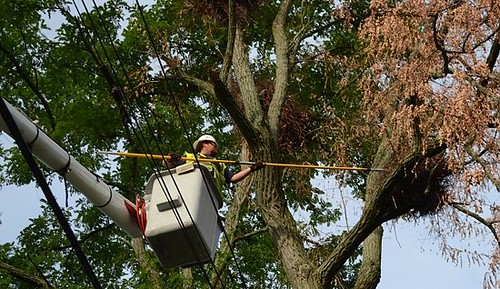 To the rescue. Image by Melissa BaileyWasyl Denysenko returned to his childhood home Monday to say goodbye to the tree his father planted 50 years ago—and to one of his parrot neighbors, the feathered victim to an emergency pruning job.
To the rescue. Image by Melissa BaileyWasyl Denysenko returned to his childhood home Monday to say goodbye to the tree his father planted 50 years ago—and to one of his parrot neighbors, the feathered victim to an emergency pruning job.
Denysenko and his 99-year-old mother watched from the porch early Monday morning as crews from the Lewis Tree Company felled an 80-foot black locust tree right outside his door near 75 Sea St.
The United Illuminating Company knocked down the tree in the interest of public safety, according to Shawn Crosbie, an environmental analyst for the utility.
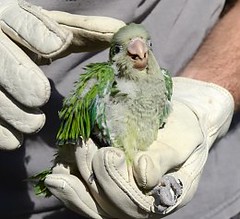 Baby monk parakeet. Image by Melissa Bailey The tree had three large nests of monk parakeets, a nonnative species of parrot that has settled along Connecticut’s coast. Workers knocked down the nests before cutting down most of the tree.
Baby monk parakeet. Image by Melissa Bailey The tree had three large nests of monk parakeets, a nonnative species of parrot that has settled along Connecticut’s coast. Workers knocked down the nests before cutting down most of the tree.
For UI’s workers, the operation was a chance to protect key power lines, and therefore the neighbors: The lines had rubbed up against the tree, prompting a fire three weeks prior. The fire left a half-dead tree that threatened to topple onto nearby cars and homes.
For Denysenko (pictured) and his mom, Alexandra, the morning provided a bittersweet time of reflection about migration and root-setting. The parakeets arrived in Connecticut around the 1960s from Argentina and Brazil, around the same time that Denysenko’s family settled here from Ukraine. The birds and the Denysenkos grew together on the corner of Howard Avenue and Sea Street. Denysenko, who’s 69, grew up there with four sisters.
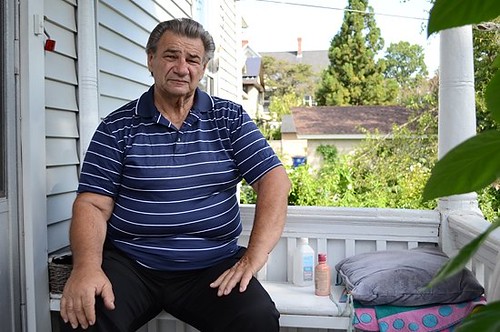 Denysenko. Image by Melissa Bailey
Denysenko. Image by Melissa Bailey
Denysenko said his dad, Alex, planted the locust in 1966, taking a 4-foot sapling from a family member’s home in Orange. Alex Denysenko loved the exotic green parrots that squawked around the neighborhood. He would pour sunflower seeds into a bird-feeder and reel it to the middle of the clothesline, attracting the birds. When the trees got big enough, the birds would settle there in large communal nests. Alex Denysenko died three years ago at the age of 98. 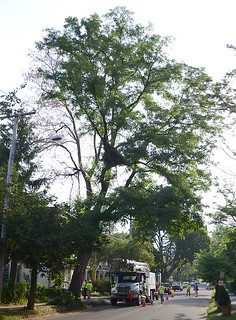 Overview of the tree. Image by Melissa Bailey
Overview of the tree. Image by Melissa Bailey
His memory was at the top of his son’s mind Monday, as the crews rolled onto Sea Street around 7:45 a.m.
Three workers from Lewis Tree Company, Donna Twigg, Anthony Simmons and Jim Lagasse, hopped out of a white bucket truck. They donned bright yellow safety vests and set to work. Officer Dave Totino showed up, too, to make sure no one got hurt.
The sound of the engine scared away most of the parrots, who had been squawking and swooping around the tree. They settled in nearby trees to make way for the workers.
A neighbor, too, scurried away to make way for the work.
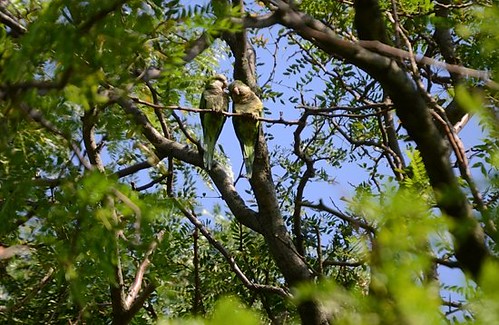 The parrots waiting keeping an eye on the happenings. Image by Melissa Bailey“I feel for the birds,” said the woman, who declined to give her name. “But I’m sure they’ll try to do it in the most humane way.” She said the tree is “an accident waiting to happen,” she said.
The parrots waiting keeping an eye on the happenings. Image by Melissa Bailey“I feel for the birds,” said the woman, who declined to give her name. “But I’m sure they’ll try to do it in the most humane way.” She said the tree is “an accident waiting to happen,” she said.
Simmons (pictured at the top of this story) grabbed a long pole with a hook on the end and jumped in the bucket. He ascended in jerky movements until he got close enough to reach the first nest. He tore away the outer sticks, then pushed the whole bundle to the ground.
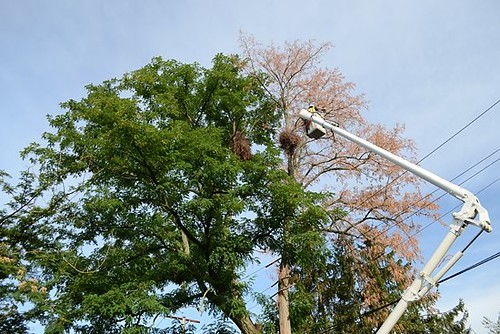 At great height. Image by Melissa BaileyOne nest fell on the truck. Another fell on the ground below.
At great height. Image by Melissa BaileyOne nest fell on the truck. Another fell on the ground below.
UI’s Crosbie said both the tree and the bird nests were causing a public safety risk. The dying half of the tree could fall on the lines, so it needed to be taken down anyway. “The birds happen to be in the tree,” so they had to go, too. Their nests could have fallen on the lines, too, he said.
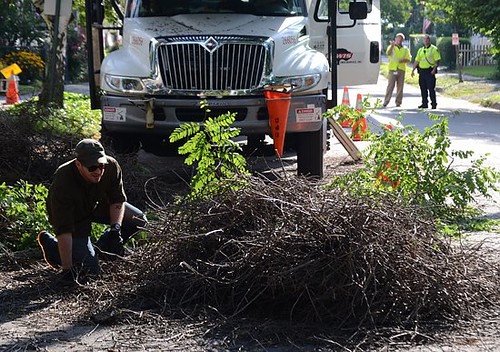 Nest on the ground. Image by Melissa Bailey“The tree’s a hazard to our electrical lines,” Crosbie said. It’s right next to a “primary line” that carries electricity right from a substation onto the streets.
Nest on the ground. Image by Melissa Bailey“The tree’s a hazard to our electrical lines,” Crosbie said. It’s right next to a “primary line” that carries electricity right from a substation onto the streets.
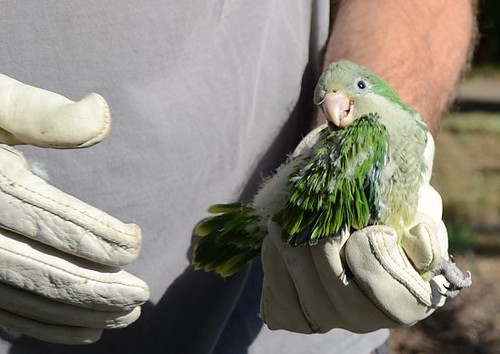 Baby monk parakeet at hand. Image by Melissa BaileyAfter Simmons knocked down all three nests, two scientists showed up to look at them. Kevin Burgio (pictured), a Ph.D. student in ecology at UConn, has been studying monk parakeets for five years. Kristof Zyskowski, the collections manager at Yale’s Peabody Museum, has a Ph.D. in ecology. His expertise is nest architecture. The two converged at 75 Sea St. and started poking around the nests.Both brought with them an enthusiastic shared interest in an unusual species. The monk parakeet, Myiopsitta monachus, is the only species of parrot that builds its own nest out of twigs. (Others dig nests into tree cavities.) The monk parakeets are so smart that they carry the twigs by the fat end of the stick, not just by the middle, the ecologists said. The monk parakeets became popular pets, then spread through the States after escaping from domesticity, Burgio said.
Baby monk parakeet at hand. Image by Melissa BaileyAfter Simmons knocked down all three nests, two scientists showed up to look at them. Kevin Burgio (pictured), a Ph.D. student in ecology at UConn, has been studying monk parakeets for five years. Kristof Zyskowski, the collections manager at Yale’s Peabody Museum, has a Ph.D. in ecology. His expertise is nest architecture. The two converged at 75 Sea St. and started poking around the nests.Both brought with them an enthusiastic shared interest in an unusual species. The monk parakeet, Myiopsitta monachus, is the only species of parrot that builds its own nest out of twigs. (Others dig nests into tree cavities.) The monk parakeets are so smart that they carry the twigs by the fat end of the stick, not just by the middle, the ecologists said. The monk parakeets became popular pets, then spread through the States after escaping from domesticity, Burgio said.
Zyskowski put on gloves and extracted several small nests made by house sparrows, which latched onto the work of the larger parrots. Then he pulled out a little, fluffy, green parrot. The bird was taking lots of short, fast breaths.
The discovery came as a surprise: No one expected to find any baby birds because the breeding season tends to be earlier in the summer. Zyskowski held the bird, which he said appeared to be about a week old, in his gloves. Then he carefully put it down in the shade of the locust tree while they further examined the nests.
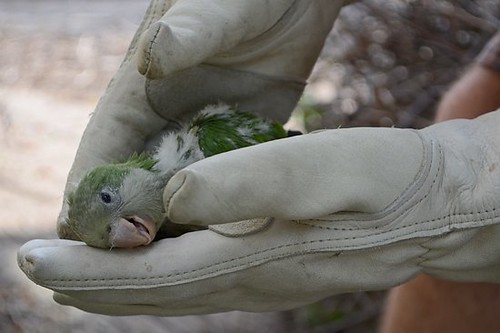 In need of help. Image by Melissa BaileyThe ecologists discussed what to do with the bird. Burgio said it’s illegal to own monk parakeets as pets, because they’re a nonnative species. Zyskowski suggested putting the bird down, so that the Peabody could keep it for science. UI’s Crosbie said the utility company works with rehabilitators to take care of injured or abandoned birds in these situations.
In need of help. Image by Melissa BaileyThe ecologists discussed what to do with the bird. Burgio said it’s illegal to own monk parakeets as pets, because they’re a nonnative species. Zyskowski suggested putting the bird down, so that the Peabody could keep it for science. UI’s Crosbie said the utility company works with rehabilitators to take care of injured or abandoned birds in these situations.
Zyskowski said you can’t tell the sex of the parrot without a DNA test.
Asked if he would name the bird, he said no: “It will get a number.”
The discussion turned out to be for naught: A few minutes later, the little bird tumbled down off the curb and issued a final convulsion. Zyskowski picked it up and pronounced it dead. He packed it into his Subaru. He said he would take it to a freezer at the Peabody for preservation.
After Zyskowski cleared away the bird and the nests, Simmons got back in the bucket and began lopping off branches with a chainsaw.
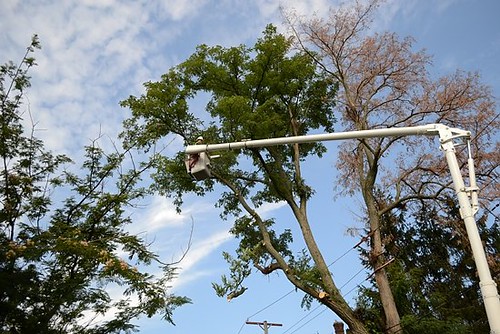 Work proceeds. Image by Melissa BaileyDenysenko watched from his porch.
Work proceeds. Image by Melissa BaileyDenysenko watched from his porch.
“It’s sad to see it go,” he said. When his father planted the tree so many years ago, he said, “we never thought it was going to grow so high.”
He said he loves watching the birds, “even though they’re very noisy.” The motorcycles on Howard Avenue are noisier, he said. Even at age 99, his mom still watches the birds from her porch every day, he said.
“It’s sad to see them go,” Denysenko said of the birds. “Hopefully they’ll get a nest nearby.”
Zyskowski said that’s very likely. Given their prevalence in the area, he said, “they’re probably here to to stay.”
 Myiopsitta monachus - Monk Parakeet | in
Myiopsitta monachus - Monk Parakeet | in  Conflict
Conflict 
